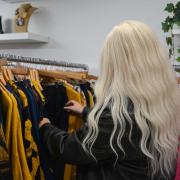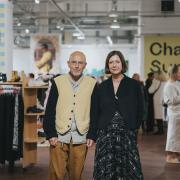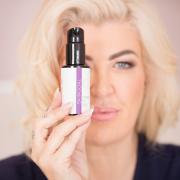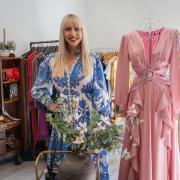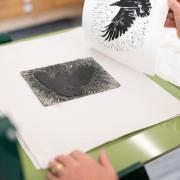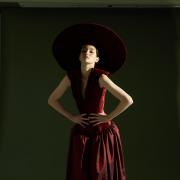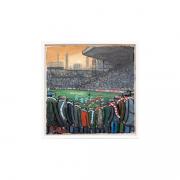Paris, Milan… Macclesfield? Katie Mulloy discovers how the town’s last-standing silk mill became a global style player for designers, celebrities and even royalty

As you wind up into the pretty little rural village of Langley, which sits on the upper edges of Macclesfield Forest and follow your sat nav's directions down a gravelly, pot-holed track running alongside a modest housing development, there's nothing overtly reassuring you that you're about to arrive at one of the most exclusive - not to mention expensive - silk printers in the world.
But then Adamley, Macclesfield's only remaining silk mill, which turned 50 this year, has made it a policy not to shout about itself.
'It's been a conscious decision to remain discreet,' says CEO Tro Manoukian who joined Adamley 16 years ago before leading a buy-out from its former parent company in 2007. 'We work with some of the leading luxury names in the fashion world. Their names are important; we can be more subdued.'
Indeed, sometimes the discretion is enforced. There are some fashion houses for whom Adamley must sign a legally-binding non-disclosure agreement. Part of this, you assume, is so competitors won't know where designers are sourcing their fabrics.

But there may also be another motivation; one which is fairly irksome to Tro.
'Our main export is to Italy. Yet a lot of British clients prefer to source their silk from Italy - there's a certain caché that comes with silk printed in Milan or Como. But the irony is that the Italians are coming to us.'
The famous Neapolitan tie maker E. Marinella, whose ties are worn by the Prince of Wales, not only sources their printed silks from Adamley but actually now owns 10% of the business. 'Still we struggle with the perception of Italian manufacturing versus UK manufacturing,' says Tro.
Yet if price is directly proportional to quality, potential customers should be reassured by its expense. 'We are the most expensive silk printer globally,' says Tro without hesitation. 'We don't hide behind that fact. We don't compromise on quality. We make sure we're offering the best printed product you can achieve. Cost is a secondary element.'

By the time that cost is passed on to a customer like you or me it means we're looking at ties from £120, pocket squares from £60. A lady's scarf would probably retail from around £300.
But then you learn about the process behind the price tag…
'We don't use any mains water on site at all. It all comes from our own reservoir - water straight from the Pennines,' says Tro. Apparently this gives the silk (which arrives in its white form from China - 'You can't get away from the fact the mulberry fields over there are the best,' says Tro) a certain lustre you just couldn't achieve otherwise.
Some of the silk (and there are various blends of it) will simply be dyed a uniform colour to order. For the silk that is to be printed, the process begins with Design Director Joanne Ratcliffe and her team.

There is an extensive archive collection at Adamley - file upon file of artwork of every print pattern ever created there as well as some acquired from other silk printers - and clients can use this as inspiration. 'A client may come to us and say, "We want a 70s retro print" and so we'd get out everything we have in the archive that relates to that and use it as a starting off point,' explains Tro. Alternatively the design team may be working from scratch: 'When we work with Liberty's, for example, every design is completely exclusive.'
To explain the printing process in detail requires a few more pages than we have here but, in short, once the pattern created by Joanne and her team is agreed it is engraved on to a screen - or a number of screens - using a snazzy piece of kit that fires hot wax on to mesh.
From here it is very much artisan in action: It is a two-man process, pushing the dye into silk, moving the screen along as they go. The required accuracy is incredible - and it is a marriage of human skill and the best equipment available. 'The tables we have here are the same as [the French fashion house]Hermès use,' says Tro. It is complex and always bespoke. Colours are applied a layer at a time, meaning they need to be mixed differently every time. Because a purple that is applied on to, say, an orange needs to be different from a purple that's layered on to a navy.
Once all the necessary dye is applied it is cured bysteaming.
I catch up with the process in a later stage when the finished material is being checked. We are looking at a pink and navy design that is destined to be cut into ties for a high-end menswear brand. There is pea-sized white mark on one section of the fabric.
'Something must have been on the material,' explains Tro. It doesn't matter that once assembled the mark would probably sit on the inside of the tie. The entire section of material the fault affects - which is probably worth £250 - will be rejected.
'Some of our clients send in their own quality assurance teams. Their standards are incredibly high and rightly so,' says Tro.
Because when you consider the names we are allowed to reveal it's rather obvious that perfection is paramount.
Adamley supply to designers from Peter Pilotto to Zac Posen to Victoria Beckham. 'Victoria Beckham is a regular customer. They are a lovely team to deal with and she is very involved,' says Tro. 'We know that she wore our material herself when she attended Prince William and Kate's wedding in 2011.'
There has been a more recent royal link. Princess Eugenie sported the firm's silk in the form of the peach Zac Posen evening gown she wore for her wedding reception last year: 'It wasn't until the palace released their statement revealing where the material was from that we knew. We'd known we were supplying for something big beforehand but not what exactly.'
Other names include the couturier Ralph & Russo whose gowns can sell for more than £20,000, the designer retailer Matches for its in-house label Raey, high-end menswear brand Drake's, bespoke shirt maker Turnbull & Asser - and, of course, Liberty of London. 'We do the prints for all their menswear accessories,' confirms Tro.
By targeting the luxury end of the accessories and fashion market, Tro has - to the degree that anyone can - protected the company from uncertain economic times. Because, to put it frankly, the super rich are unbothered by such things. 'When I joined this company 16 years ago I was basically brought in to shut it down. Back then they were losing between £20-40,000 a month.'
Instead he turned it around and has quietly been building a stealth global brand ever since. Little Adamley is a pretty big deal. You just have to know where to find it.






